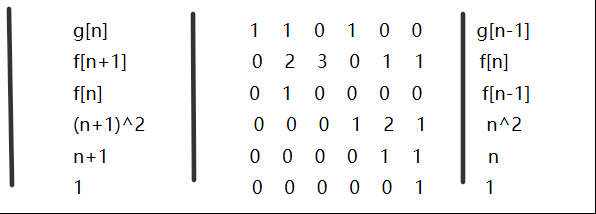链接:https://ac.nowcoder.com/acm/contest/221/C
来源:牛客网
令f(n)=2*f(n-1)+3*f(n-2)+n,f(1)=1,f(2)=2
令g(n)=g(n-1)+f(n)+n*n,g(1)=2
告诉你n,输出g(n)的结果,结果对1e9+7取模
令g(n)=g(n-1)+f(n)+n*n,g(1)=2
告诉你n,输出g(n)的结果,结果对1e9+7取模
输入描述:
多组输入,每行一个整数n(1<=n<=1e9),如果输入为0,停止程序。
输出描述:
在一行中输出对应g(n)的值,结果对1e9+7取模。
备注:
项数极大,朴素算法无法在规定时间内得出结果
PS:快速幂的一般形式为B`=A^N*B(其中B`和B的形式是一样的,只是下标相差1)
B`和B、A都是n阶方阵

#include <iostream> #include<string.h> #include<stdio.h> #define ll long long using namespace std; const ll mod = 1000000007; struct mat { ll m[6][6]; mat() { memset(m, 0, sizeof(m)); } }; mat mul(mat &A, mat &B) { mat C; for (int i = 0; i < 6; i++) { for (int j = 0; j < 6; j++) { for (int k = 0; k < 6; k++) { C.m[i][j] = (C.m[i][j] + A.m[i][k] * B.m[k][j]) % mod; } } } return C; } mat pow(mat A, ll n) { mat B; B.m[0][0] = 8; B.m[1][0] = 10; B.m[2][0] = 2; B.m[3][0] = 9; B.m[4][0] = 3; B.m[5][0] = 1; while (n) { if (n & 1) B = mul(A, B); A = mul(A, A); n >>= 1; } return B; } int main() { ll n; while (cin >> n&&n!=0) { mat A; A.m[0][0] = A.m[0][1]= A.m[0][3]=1; A.m[1][1] = 2;A.m[1][2]=3;A.m[1][4]=A.m[1][5]=1; A.m[2][1] = 1; A.m[3][3]=1;A.m[3][4]=2;A.m[3][5]=1; A.m[4][4] = A.m[4][5]=1; A.m[5][5] = 1; if(n==1) cout<<2<<endl; else if(n==2) cout<<8<<endl; else { mat B = pow(A, n-2); printf("%lld ", B.m[0][0]); } } return 0; }